In the fast-paced startup ecosystem of 2025, a striking trend has emerged: nearly half of early-stage companies now rely on AI-generated code to launch their Minimum Viable Products (MVPs), often dubbed “vibe-coded” systems, to test market fit at unprecedented speeds. This phenomenon reflects a broader shift in how innovation is prioritized over perfection, allowing founders to transform concepts into functional prototypes within days. Yet, beneath this rapid progress lies a pressing challenge—determining the critical moment to transition from these makeshift solutions to robust backend architectures capable of sustaining growth. This industry report delves into the lifecycle of vibe-coded MVPs, examines their role in the startup landscape, identifies the risks of prolonged reliance, and provides strategic guidance on timing an upgrade to ensure long-term success.
Understanding Vibe-Coded MVPs in Today’s Startup Landscape
The rise of vibe-coded MVPs marks a significant evolution in how startups approach product development. These prototypes, built using AI tools to generate code swiftly, have become a cornerstone for validating business ideas without the need for extensive engineering resources. Particularly in sectors like logistics and food tech, where speed to market can define competitive advantage, such systems empower even non-technical founders to create working products that capture early user feedback.
This trend has reshaped the startup ecosystem by lowering entry barriers and accelerating innovation cycles. Key market players, including AI code generation platforms, have fueled this movement by offering accessible solutions that churn out functional codebases in mere hours. Their impact is evident in the growing acceptance of vibe-coded prototypes as legitimate tools for early-stage development, with investors increasingly valuing live demos over traditional pitch decks.
Moreover, the cultural shift toward embracing rapid experimentation has solidified the relevance of these MVPs. Startups now prioritize iterative learning, using AI-driven prototypes to test hypotheses and refine offerings before committing to full-scale development. This approach not only conserves capital but also aligns with the dynamic demands of modern markets, where adaptability often trumps polished perfection in the initial phases.
The Lifecycle of a Vibe-Coded MVP: From Quick Wins to Hidden Risks
Initial Advantages and Early Success
Vibe-coded MVPs offer unparalleled speed, enabling startups to move from ideation to deployment in record time. This rapid development cycle allows founders to bypass lengthy hiring processes or expensive outsourcing, bringing functional products to life with minimal investment. For non-technical entrepreneurs, this accessibility is transformative, democratizing the ability to launch and iterate without deep coding expertise.
Beyond speed, these prototypes play a pivotal role in market validation. By presenting live, interactive products to potential users and stakeholders, startups can gather real-world insights that static mockups or presentations cannot replicate. This hands-on feedback often proves instrumental in refining value propositions and identifying core pain points before scaling.
Additionally, vibe-coded systems enhance fundraising efforts by showcasing tangible progress. Investors are more likely to engage with a working demo that illustrates a startup’s vision, as opposed to conceptual slides. This visual and functional storytelling has become a powerful tool in securing early-stage funding, positioning such MVPs as strategic assets during pitch meetings.
Growing Pains and Unintended Longevity
As startups gain traction, a common pitfall emerges: vibe-coded MVPs, initially designed as temporary proofs of concept, often linger in production environments far beyond their intended lifespan. When user bases grow and revenue starts flowing, these makeshift systems are pressed into supporting critical operations, creating a dangerous mismatch between their capabilities and real-world demands.
This unintended longevity introduces significant operational risks. Technical limitations, such as poor scalability and inconsistent performance, begin to surface as traffic increases or new features are added. Partnerships with larger enterprises or sudden viral growth can further expose these weaknesses, threatening the stability that customers and stakeholders expect.
Moreover, the longer a startup relies on a vibe-coded backend, the more entrenched these risks become. What begins as a quick win transforms into a liability, with founders facing mounting pressure to maintain service levels while grappling with a system never built for durability. Recognizing this shift is essential to avoid costly disruptions down the line.
Challenges and Limitations of Vibe-Coded Backends
The technical shortcomings of vibe-coded systems often stem from their very nature—code generated piecemeal by AI tools across multiple sessions lacks cohesive structure. Inconsistent coding patterns, undocumented functionalities, and hidden dependencies create a fragile foundation that struggles under real-world loads. Engineers tasked with maintaining such systems frequently describe them as disjointed, complicating even minor updates.
Operationally, these backends falter when faced with sudden demands, such as traffic spikes from marketing campaigns or viral adoption. System instability leads to timeouts, errors, and frustrated users, while customer support teams bear the brunt of escalating complaints. Perhaps most concerning is the pervasive fear of making changes, as unclear dependencies raise the risk of unintended breakdowns with every tweak.
Mitigating these challenges requires proactive steps, starting with thorough audits to map out existing code and identify critical vulnerabilities. Startups should also establish interim monitoring tools to track performance and flag issues before they escalate. Planning for a transition to a robust backend must begin early, prioritizing incremental improvements to stabilize operations while a more sustainable architecture is developed.
Business and Regulatory Triggers for Upgrading
Certain business milestones signal an urgent need for a backend overhaul, particularly when revenue becomes dependent on system reliability. As startups scale, investor scrutiny intensifies, with questions arising about downtime risks and the ability to confidently adapt without breaking core functionalities. These concerns often push founders to prioritize a technical upgrade to safeguard financial stability.
Enterprise clients introduce another layer of pressure, demanding stringent service level agreements (SLAs) and detailed audit logs that vibe-coded systems cannot reliably provide. In industries like finance and healthcare, regulatory requirements add further complexity, mandating secure handling of sensitive data and compliance with strict standards. Falling short in these areas can jeopardize contracts and erode trust.
Aligning technical upgrades with broader business goals is crucial during this phase. Decisions to transition should account for market expansion plans, upcoming funding rounds, and the need to present a credible architecture to potential partners or acquirers. By tying backend improvements to strategic objectives, startups can justify the investment and ensure a seamless shift that supports long-term growth.
Strategic Timing and Future-Proofing Your Backend
Determining the optimal moment to transition from a vibe-coded MVP to a robust backend involves balancing technical necessities with business pressures. Indicators such as consistent performance issues or looming enterprise deals often serve as catalysts, while external factors like market expansion or investor expectations can accelerate the timeline. Striking this balance prevents premature overhauls that drain resources or delayed upgrades that risk collapse.
Emerging trends in AI-driven development point to a more nuanced role for such tools in the coming years. Rather than acting as the sole architect of production systems, AI is increasingly positioned as a co-author, assisting with prototyping, API scaffolding, and test drafting under human oversight. This shift aims to harness the speed of AI while ensuring reliability through deliberate design, a trend likely to shape development practices through 2027 and beyond.
Building scalable architectures from the outset of a transition is vital for future-proofing. Startups must prioritize modular designs that accommodate growth, meet rising consumer expectations for uptime, and withstand potential disruptions like sudden demand surges. Investing in observability and tested integrations now lays the groundwork for resilience, ensuring that technical foundations evolve alongside business ambitions.
Conclusion
Reflecting on the insights gathered, the journey from vibe-coded MVPs to robust backends stands as a defining milestone for startups navigating growth in 2025. The analysis highlighted how initial speed and accessibility often give way to technical fragility and operational strain, underscoring the inevitability of an upgrade. Business and regulatory pressures further amplified the urgency, revealing that timing plays a pivotal role in mitigating risks.
Looking ahead, startups are encouraged to adopt a phased approach to transitions, isolating critical domains for immediate overhaul while gradually phasing out legacy code. Leveraging AI as a collaborative tool rather than a sole creator offers a balanced path forward, blending innovation with stability. Ultimately, viewing this shift as a strategic evolution rather than a remedial fix empowers companies to build architectures poised for scalability, setting a strong precedent for sustainable success in an ever-competitive landscape.









